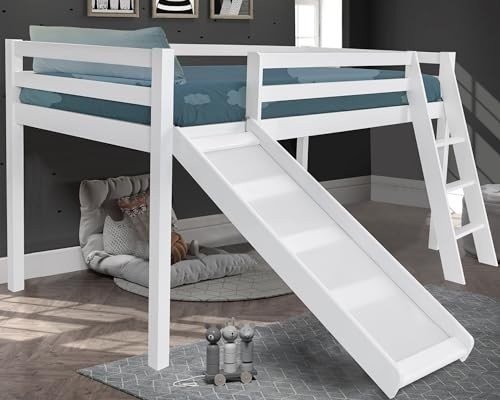You'll Never Guess This Kids Bunk Bed's Secrets
The Ultimate Guide to Kids Bunk Beds: Maximizing Space and Fun
With the rise of vertical living and smaller sized spaces, the appeal of bunk beds has actually skyrocketed amongst families. Bunk beds not just use a practical sleeping service, especially in shared rooms, however they also bring a component of fun into a child's life. This thorough guide looks into the features, advantages, and considerations of kids' bunk beds, making it simpler for parents to choose the best bed for their little ones.
Functions of Kids Bunk Beds
Bunk beds are flexible furniture pieces that serve more than a single purpose. Here are some essential features to consider:
Feature
Description
Material
Bunk beds can be built from wood, metal, or a combination of both, providing differing levels of sturdiness and style choices.
Security Features
Many bunk beds come geared up with guardrails, safe ladders, and capped assistances for security, particularly important for kids.
Design Variety
Options vary from timeless designs to modern-day styles, guaranteeing a match for any room decoration.
Space-Efficiency
Bunk beds make use of vertical space, making them ideal for smaller spaces.
Convertible Options
Some designs can be transformed into 2 separate beds, providing versatility as kids grow.
Storage Solutions
Some bunk beds feature integrated storage drawers or racks, assisting to keep the room organized.
Benefits of Kids Bunk Beds
Purchasing a bunk bed comes with several benefits:
- Space Saving: Bunk beds optimize flooring space, allowing for more backyard or storage options.
- Enjoyable Factor: With a bunk bed, kids have a location that cultivates imagination and friendship during sleepovers or playdates.
- Cost-efficient: Instead of buying 2 separate beds, a bunk bed can accommodate two children at the same time, saving cash in the long run.
- Adaptability: Many bunk beds can be disassembled or transformed into twin beds, making them a long-term investment as kids's requirements change.
- Social Interaction: Bunk beds encourage family bonding and friendships, providing an inviting space for children to share stories and laughter.
Factors to consider When Choosing a Kids Bunk Bed
When picking the ideal bunk bed for a kid, parents ought to consider numerous aspects:
- Safety Standards: Ensure that the bunk bed complies with security guidelines and includes essential security functions.
- Age Appropriateness: Different models accommodate different age. For instance, traditional bunk beds may not appropriate for more youthful kids.
- Room Dimensions: Measure the bedroom to make sure the bunk bed fits appropriately, permitting for space to move easily.
- Weight Capacity: Consider the weight load of each bed and ensure it accommodates the child's weight easily.
- Design Preferences: Letting children take part in the selection procedure can assist them feel more fired up about their brand-new bed.
Types of Kids Bunk Beds
Bunk beds come in different designs and setups to match various needs:
Type
Description
Standard Bunk Bed
A classic design with one bed stacked on top of another, normally utilizing a ladder to access the leading bunk.
L-Shaped Bunk Bed
Features 2 bunk beds connected in an L-shape, often more roomy and appropriate for kids sharing a space but needing a bit more space.
Triple Bunk Bed
Comprises 3 stacked beds, perfect for optimizing sleeping plans in extremely restricted spaces.
Loft Bed
A raised bed with space underneath that can act as a play area, study corner, or additional storage.
Futon Bunk Bed
Combines a bunk bed on the top with a futon or couch underneath, making it great for pajama parties and optimizing room use.
Convertible Bunk Bed
Can be separated into two private beds, providing flexibility as children's needs change.
Taking Care Of Kids Bunk Beds
Preserving bunk beds is essential for making sure longevity and safety. Here are some basic care practices:
- Regular Inspections: Check the bed routinely for loose screws and tightened up bolts to ensure stability.
- Cleanliness: Keep bedding clean and fresh, turning bed mattress for even use.
- Guardrails: Ensure guardrails are safe and in place, specifically if kids tend to move around a lot in their sleep.
- Air Circulation: Ensure the bed has adequate air flow, preventing wetness accumulation that can cause mold or mildew.
FAQs About Kids Bunk Beds
Q1: At what age can a child safely utilize a bunk bed?
A1: Generally, kids aged six and older are thought about safe to utilize the upper bunk due to the height and stability elements involved.
Q2: Can I put a bunk bed near a window?
A2: It is a good idea to avoid putting a bunk bed near windows to minimize the risk of falling or injuries.
Q3: Are bunk beds safe for more youthful kids?
A3: While some modern-day bunk beds feature security functions accommodating more youthful children, it is generally recommended to wait up until they are older, generally over 6 years.
Q4: What is the normal weight limit for top bunks?
A4: Weight limitations differ by model but usually range from 150 to 250 pounds. Always describe click this over here now .
Q5: How typically should I examine the bunk bed's safety functions?
A5: It is suggested to carry out a safety check every few months or whenever you observe any signs of wear.
Kids' bunk beds act as a strategic service for households wanting to make the most of space while offering a fun and engaging sleeping environment for their kids. With a variety of choices offered— from basic styles to loft beds— parents have the freedom to select something that fulfills their household's specific requirements. By considering crucial aspects such as security, room viability, and their children's preferences, parents can make an educated choice, making sure that each kid is thrilled about bedtime while benefiting from a well-organized space.
